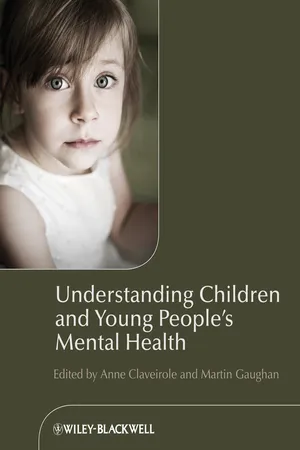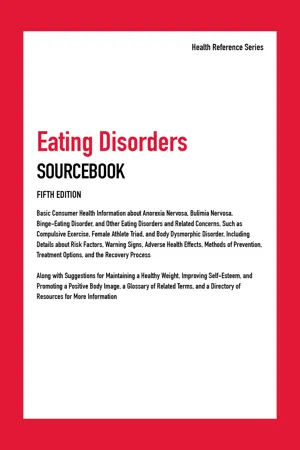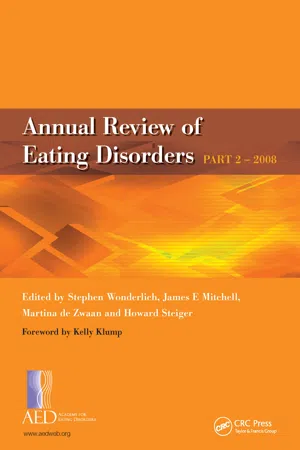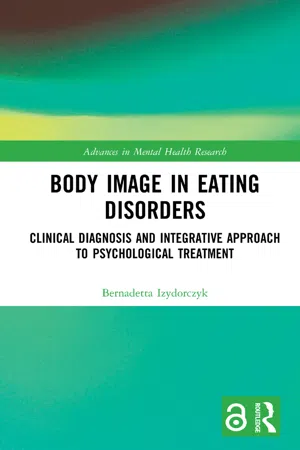Psychology
Causes of Eating Disorders
Eating disorders can be caused by a combination of genetic, psychological, environmental, and social factors. Genetic predisposition, low self-esteem, societal pressure for thinness, and traumatic life events are often cited as contributing factors. Additionally, personality traits such as perfectionism and impulsivity can also play a role in the development of eating disorders.
Written by Perlego with AI-assistance
Related key terms
11 Key excerpts on "Causes of Eating Disorders"
- eBook - ePub
Nutrition
Science and Applications
- Lori A. Smolin, Mary B. Grosvenor(Authors)
- 2019(Publication Date)
- Wiley(Publisher)
bulimia nervosa , and binge-eating disorder . Table F2.1 summarizes characteristics that can be used to distinguish these.Table F2.1Distinguishing among Eating DisordersEating disorder Characteristic Anorexia nervosa Bulimia nervosa Binge-eating disorder Body weight Below normal Normal or overweight Above normal Binge eating Possibly Yes, at least once a week for three months Yes, at least once a week for three or more months Purging Possibly Yes, at least once a week for three months No Restricts food intake Yes Yes Yes Body image Dissatisfaction with body and distorted image of body size Dissatisfaction with body and distorted image of body size Dissatisfaction with body Fear of being fat Yes Yes Not excessive Self-esteem Low Low Low Typical age of onset Adolescence/young adulthood Adolescence/young adulthood Adolescence and any age during adulthood F2.2 What Causes Eating Disorders?
LEARNING OBJECTIVES
- Describe the genetic, psychological, and sociocultural factors that influence the development of eating disorders.
- Discuss how body ideal and the media affect the incidence of eating disorders.
We do not completely understand what causes eating disorders, but we do know that genetic, psychological, and sociocultural factors contribute to their development (Figure F2.1 ). Eating disorders can be triggered by traumatic events such as sexual abuse or by day-to-day occurrences such as teasing or judgmental comments by a friend or a coach. Eating disorders occur in both genders and in people of all ages, races, and socioeconomic backgrounds, but some groups are at greater risk than others.2 - Anne Claveirole, Martin Gaughan, Anne Claveirole, Martin Gaughan(Authors)
- 2011(Publication Date)
- Wiley-Blackwell(Publisher)
Surprisingly, given the high personal and literal costs eating disorders involve, no single unifying explanatory model has been established. Also, many experts contend that no one risk factor is ever likely to explain disorders so inherently complex (Nicholls 2007). Instead, eating disorders research examines a number of key causative theories and associated risk and resilience factors. Unsurprisingly, some of this research is contentious and intermittently contradictory.The solution to these problems lies with a pragmatic approach that eating disorders arise as a combination of biological, psychological and social forces (Lucas 2008). The precise interaction involved is unique to each person, as is the trigger to their illness beginning, and often their paths to recovery (Lucas 2008). It is only at certain points, e.g. when people are starving as a result of anorexic behaviour that eating disorders appear similar (Lucas 2008).We will now examine the main biological, psychological and social themes in turn.Biological FactorsGenetic vulnerabilityMost psychiatrists are confident that eating disorders run in families, although researchers are unsure exactly how that risk is realised, including the extent of inherited traits, such as perfectionism, versus environmental influences (Goodman and Scott 2005, Nicholls 2007, Treasure 2007). The number of genes involved and the precise extent to which they influence the development of a disorder are also unknown and vary in the literature. Lucas (2008), for example, states that genes account for up to 70% of a disorder developing, with the remaining 30% arising from a person’s environment.Neurological vulnerabilityNeuroscientific research proposes that specific deficits in brain structures and functions are involved in eating disorders, and that the neurological, physical and social changes puberty brings influence their development (Southgate et al- eBook - ePub
- James Chambers, James Chambers(Authors)
- 2019(Publication Date)
- Omnigraphics(Publisher)
This chapter contains text excerpted from the following sources: Text beginning with the heading “What Is Body Image?” is excerpts from “Having Body Image Issues,” girlshealth.gov, Office on Women’s Health (OWH), January 7, 2015. Reviewed December 2018; Text under the heading “Body Image and Mental Health” is excerpted from “Body Image and Mental Health,” Office on Women’s Health (OWH), U.S. Department of Health and Human Services (HHS), May 17, 2018.Chapter 22 Environmental Factors in Eating Disorder DevelopmentResearchers cannot pinpoint a single cause for eating disorders. Instead, they view eating disorders as complex illnesses that can have a variety of contributing causes, including genetic, biological, psychological, social, and environmental factors. Some of the environmental factors that may increase the likelihood of an individual developing an eating disorder include sociocultural pressures to attain a certain standard of thinness, media messages about diet and weight loss, exposure to traumatic events, stressful or chaotic family dynamics, and mothers who frequently express dissatisfaction with their own bodies or criticize their daughters’ body shape or weight.Sociocultural IdealsAmerican media and popular culture promote an image of the ideal or “perfect” body that is unattainable for most people. Fashion models, actors, and celebrities featured onscreen or in magazines tend to fall within a narrow set of norms that include only those who are extremely thin or extremely muscular, and editing technologies such as Photoshop and airbrushing are often employed to remove any blemishes, wrinkles, or love handles. When people internalize these unrealistic standards of beauty, it may contribute to the development of a negative body image, an obsession with weight and appearance, and eating disorders. Although many people who are exposed to sociocultural ideals of thinness do not develop eating disorders, studies have shown that some individuals are highly vulnerable to such environmental messages about weight and beauty.DietingIn response to societal pressures to attain a certain ideal body shape, many people resort to restrictive dieting or other extreme weight loss measures. Americans spend an estimated $60 billion each year on fad diets and dangerous weight loss products, despite the fact that 95 percent of people on diets fail to achieve permanent weight loss. In addition to their ineffectiveness, restrictive diets are also a common precipitating factor in the development of eating disorders. Dieting increases people’s preoccupation with food and weight and generates feelings of guilt and shame surrounding eating. For some people, these feelings contribute to the development of eating disorders. - eBook - ePub
Clinical Psychology
A Global Perspective
- Stefan G. Hofmann, Stefan G. Hofmann(Authors)
- 2017(Publication Date)
- Wiley-Blackwell(Publisher)
Table 13.3 summarizes essential findings regarding the etiology of eating disorders. From a transdiagnostic eating disorder perspective (Fairburn, Cooper, & Shafran, 2003) as well as relevant research studies (e.g., Fairburn et al., 2015; Hilbert et al., 2014; Stice, Marti, & Durant, 2011), it is apparent that the various eating disorders share more commonalities than differences with regard to mechanisms of development, onset and maintenance.Development, first onset and maintenance of eating disorders (adapted from Tuschen‐Caffier & Hilbert, 2016).Table 13.3Development Individual factors: typical for eating disorders - obesity in childhood and youth
- genetic factors
Environmental factors: typical for eating disorders- parents' overweight
- parental or familial eating problems
- restrictive parenting style in terms of diet
Individual factors: general vulnerability factors- problems with executive functions (e.g., impulsivity)
Environmental factors: general vulnerability factors- psychopathology of parents or other family members
- experiences of physical violence or sexual abuse
First onset Individual factors: - worry about shape and weight (typical for eating disorders)
- restrained eating (typical for eating disorders)
- lack of self‐esteem (general vulnerability factor for mental disorders)
Environmental factors: general vulnerability factors- stress, e.g., critical life events like divorce (general vulnerability factors)
- negative comments on shape and weight (typical for eating disorders)
- eBook - ePub
Helping People with Eating Disorders
A Clinical Guide to Assessment and Treatment
- Bob Palmer(Author)
- 2014(Publication Date)
- Wiley-Blackwell(Publisher)
It seems most likely that sustained disturbance of eating behaviour will be promoted by emotion mainly when the scene has already been set by some disruption of ‘normal’ feeding. That disruption may be a decision to restrain eating but could also be a predominantly emotional event. Anecdotally, people do differ in the extent to which they are readily ‘put off their food’ by emotional upset and, indeed, in the extent to which they ‘eat for comfort’. Such individual differences may well be relevant to the risk of developing eating disorder, although at present they are poorly understood. Satisfactory explanatory models of eating disorders are likely to involve both restraint and its consequences and emotional issues (McManus & Waller, 1995; Meyer et al., 1998); however, it should be remembered that a proportion of cases of BN seem to lack a history of notable eating restraint, and this proportion is substantial for cases of BED. In such cases, it may be that emotional factors alone, or with some primary problem of eating regulation, lead to clinical eating disorder.FAMILY INFLUENCES
Troubled people often come from troubled families. Families provide food for children and are the context for emotional development. It may well be that styles of eating and relating to food are set down in childhood as a result of family influences. It is plausible that families may be involved in triggering or perpetuating eating disorders. There has certainly been a lot of speculation along these lines. However, it is also true that troubled people upset families and the presence of an eating-disordered member in a family is likely to upset the other family members. The evidence from clinical observation and the theories that arise from it need to be considered with this in mind.Many theorists have made bold statements about the way in which family life and parenting promote eating disorders. For instance, Bruch (1973) asserted the importance of the mother–child relationship and Selvini-Palazzoli (1974) that of the whole family system. However, such theories are largely unsupported by systematic research and seem insupportable as particular and specific aetiological theories. Furthermore, they have sometimes led to regrettable attributions of blame which tend to hinder rather than help any therapeutic endeavour. What evidence there is about the current family life of those suffering from eating disorders suggests that there is a wide variety rather than one or two consistent patterns (Rastam & Gillberg, 1991). On the whole, the stereotypes of the theorists have not been found (Eisler, 1995). However, there is some evidence that sufferers remember their childhood as characterised by a variety of negative features, most of which they share with people with other psychiatric disorders. Furthermore, some adverse family environmental factors, such as low contact and high expectations, have been found to be more common in the recollections of both bulimia and anorexia sufferers than in comparable subjects with other psychiatric disorders (Fairburn et al., 1997, 1999). Indeed, the general force of such family risk factors seems to be especially great for BN. A large twin study used multivariate analyses to try to tease out the likely influence of genetic and shared familial and non-shared environmental factors in BN and five other psychiatric disorders (Kendler et al., 1995). Alone amongst the six disorders studied, the model for BN suggested a significant aetiological role for familial environmental factors. Some studies suggest fewer overt problems in the childhood background of AN sufferers (Schmidt, Tiller, & Treasure, 1993; Webster & Palmer, 2000). - eBook - ePub
- Stephen Wonderlich, James Mitchell, Martine de Zwaan(Authors)
- 2018(Publication Date)
- CRC Press(Publisher)
Identifying those who are most at risk for developing an eating disorder provides the opportunity to intervene at an early stage, or ideally, to prevent the onset of problematic eating behaviors. Therefore, understanding the factors that contribute to psychosocial risk for eating disorders (ED) is important for both prevention and early intervention efforts. The literature to be reviewed comprises the published articles that investigate psychosocial risk factors for ED, disordered eating, and eating disorder-related concerns (e.g. body dissatisfaction) in the years 2004 and 2005. Findings from previous risk factor papers will be summarized briefly before the details from recently published studies are provided.Summary of previous risk factor studies and reviews
In their comprehensive review, Striegel-Moore and Cachelin (2001) categorized risk factors into five groups: demographic; sociocultural; familial; constitutional; and personality variables. Prospective studies indicate that both personal vulnerability factors (i.e. psychopathology, negative affectivity, low self-esteem, internalized thin-ideal, body image concerns, and dieting) and constitutional vulnerability factors (i.e. childhood obesity, body fat, early onset of menarche, and perfectionism) predicted full and partial syndrome ED. In a series of community-based case-control studies, Fairburn et al . (1997; 1998; 2000) found that only two factors distinguished the anorexia nervosa (AN) cases from the psychiatric control cases: negative self-evaluation and perfectionism. Similarly, for the bulimia nervosa (BN) cases, only obesity risk and high parental expectations significantly differentiated eating disorder cases from the psychiatric control group. The McKnight Investigators (2003) assessed 1103 girls in grades 6–9, who were followed for four years. Results indicated that thin body preoccupation and social pressure increased risk for full and partial syndrome cases and that some Hispanic groups were also at higher risk. Jacobi et al - eBook - ePub
- Ron A. Thompson, Roberta Trattner Sherman(Authors)
- 2011(Publication Date)
- Routledge(Publisher)
4 Risk Factors for the Development of Problem EatingIdentification of risk factors for eating disorders is important for determining high-risk groups, for designing prevention programs, and for public policy (Striegel-Moore & Bulik, 2007). In this chapter, we will first discuss general (non-sport-related) factors that put individuals at risk for developing an eating disorder—factors that may predispose people to such disorders without regard to sport participation. A full discussion of the risk factors for eating disorders is well beyond the scope of this book. Thus, we will confine our general discussion to two areas of particular interest to researchers and practitioners: genetic and sociocultural factors.We will then discuss the sport-related risk factors, that is, risk factors that are unique and specific to the sport environment and sport participation. Because sport participants encounter both general and sport-specific risk factors, they are more at risk than those who do not participate in sport. Based on the literature reviewed in Chapter 3 , this may or may not result in more eating disorders. Eating disorders are multiply determined; that is, they result from a combination of factors. Whether such a disorder occurs in an individual in sport will be dependent on an interaction of factors, with sport participation being one of them.Although sport participants are at increased risk, we do not believe that sport participation should be avoided. On the contrary, sport participation can have a positive effect on general psychological factors, such as psychological well-being (DiBartolo & Shaffer, 2002) and feeling worthwhile (Petrie, 1996), as well as more specific psychological factors, such as self-efficacy (Taub & Blinde, 1992) and self-perceptions of competence and ability (Biddle, 1993). Regarding eating disorders, it has been suggested that sport participation in some cases might act as a buffer against eating-related problems (Fulkerson, Keel, Leon, & Dorr, 1999; Morse, 2008; Wilkins, Boland, & Albinson, 1991). Thus, it is not sport participation that should be avoided, but rather the risks associated with sport. Evidence of this is provided in a study by Hulley, Currie, Njenga, and Hill (2007) in which they compared Kenyan runners, runners from the UK, Kenyan non-sport–participant controls, and a control group of non-sport participants from the UK. Although 19.5% of the UK runners had a present or past eating disorder, the Kenyan runners had the lowest prevalence of such disorders of all four groups and had the least eating disorder pathology. Hulley et al. concluded that distance running in and of itself does not predispose a runner to an eating disorder, but rather eating disorder risk is a combination of risk factors that include culture, sport, and the person—factors that will be discussed in the sections that follow. - eBook - ePub
- Stephen A. Wonderlich, James E. Mitchell, Martina de Zwaan(Authors)
- 2018(Publication Date)
- CRC Press(Publisher)
3Sociocultural influences on eating disorders Pamela K Keel and Julie A GravenerAbstractObjectives of review. This chapter reviews articles published in 2005 and 2006 on the influence of culture, ethnicity and gender on eating disorders. Specific social environmental factors, including media portrayals of body ideals and peer and family environment, are also reviewed.Summary of recent findings. Certain non-Western values may increase the risk of eating disorders. Ethnicity and gender may moderate associations between risk factors and disordered eating. The media promote different body image ideals for women and men that may contribute to gender differences in the rates and expression of eating disorders. Peers and family translate broad cultural values into personally relevant ideals that influence behavior.Future directions. Much of the research on sociocultural factors remains focused on the role of the thin ideal. Future work could examine the influence of collectivism, anonymity, and shifts from multigenerational to predominantly peer social environments as possible sociocultural factors that increase the risk of eating disorders.Introduction
Eating disorders are most likely to occur in females from industrialized nations (American Psychiatric Association 2000), and appear to be less common among some ethnic subgroups (Striegel-Moore et al. 2003). These patterns raise questions about how membership of a given culture, ethnic group and gender influence disordered eating. We review literature that addresses cultural influences on eating disorders. In addition, we examine how social factors, such as peer and family environment, influence risk. We view social and cultural factors as representing levels of influence. However, the organization of this review is not meant to imply a unidirectional order of influence. For example, gender is negotiated within cultural and ethnic groups, yet certain aspects of gender may transcend cultural or ethnic group boundaries (Safir et al. - eBook - ePub
Working With Eating Disorders
A Psychoanalytic Approach
- Geraldine Shipton(Author)
- 2017(Publication Date)
- Bloomsbury Academic(Publisher)
2THE CULTURAL CONTEXT OF EATING DISORDERS
The connections between the society we live in and the roles we are expected to play in it clearly affect how we think about ourselves and how we behave. However, the specific ways in which culture, in its most general meaning, affects the individual’s unconscious is impossible to predict with certainty. Yet advertising makes an assumption that it can influence us with some degree of accuracy: who amongst us has not looked at the billboards which advertise products adorned by a very slender, scantily clad woman and not thought ‘what is that telling us about how women should look and about what we should want?’. We can analyse the messages and the images but we cannot be sure how they are read or received. Some of us will buy the products advertised, some of us will diet to look like the model and others amongst us might resolve not to buy that brand of vodka or jeans. It quite simply varies! We have a choice about how we react. Nonetheless, eating disorders are believed to be on the increase and many commentators have puzzled about why that should be so. Fonagy cautioned: ‘… we are rarely able to comment meaningfully on demographic trends such as recent increases in the prevalence of eating disorders or the varying prevalence of disorders across the life-span …’ (Fonagy, 1999).Many previous writers have tried to make some links with social processes in understanding eating disorders. In particular, there is a history of a feminist perspective, which has aimed not to split women who seek help from the rest of the female population for whom the body and food are an everyday preoccupation. Pioneering American feminists of the late twentieth century, like Chernin, and Bordo, and feminists based in Britain, like Orbach, Eichenbaum, Lawrence and others, have highlighted some common themes about how society relates to the female body. I will briefly consider these and more contemporary perspectives before mentioning the sociology of embodiment. I will then return to the belief that eating disorders are on the increase and that they have special significance for women. Any approach to thinking about cultural dimensions of clinical problems must take into account the small number of men (an estimated 10 per cent of sufferers) who develop eating disorders. But first of all I want to sketch out a brief history of eating. - eBook - ePub
- Linda Smolak, Michael P. Levine(Authors)
- 2015(Publication Date)
- Wiley-Blackwell(Publisher)
67 Toward an Integrated Biopsychosocial Model of Eating DisordersLinda Smolak and Michael P. LevineDepartment of Psychology, Kenyon College, USAFor at least 40 years theorists have argued that etiological models of eating disorders (EDs) should be multidimensional (Garfinkel & Garner, 1982). Indeed, there are many such models available, including recent variants presented by Kaye, Bailer, and Klabunde (2012) and Wertheim, Paxton, and Blaney (2009). Most theorists, researchers, and clinicians in the field endorse a multidimensional approach.It is, then, a bit surprising that the two dominant paradigms in current ED theory emphasize almost opposite approaches to etiology. One, the biopsychiatric or biologically based mental illness (BBMI) approach, emphasizes genetic factors and brain functioning (Kaye et al., 2012; Klump, Bulik, Kaye, Treasure, & Tyson, 2009; Nunn, Lask, & Frampton, 2011; Strober & Johnson, 2012; see also Chapters 17 , 28 , & 30 ). In contrast, the sociocultural model focuses on cultural themes and practices that are transmitted through convergent social messages about body shape, weight, and the controllability or malleability of weight and shape (Stice, 1994; Thompson, Heinberg, Altabe, & Tantleff-Dunn, 1999; see also Chapters 21 , 26 , 29 , & 31 ).Certainly both types of theory routinely include other variables, most commonly personality or temperament characteristics (e.g., perfectionism, harm avoidance; see Chapter 32 ) and environmental stressors (e.g., poor parenting, sexual abuse, subcultures that enforce a drive for thinness and a fear of fat; see Chapters 34 & 35 - eBook - ePub
Body Image in Eating Disorders
Clinical Diagnosis and Integrative Approach to Psychological Treatment
- Bernadetta Izydorczyk(Author)
- 2021(Publication Date)
- Routledge(Publisher)
- Try to remember that family life does not focus entirely on the person with an eating disorder and that they do not consciously take advantage of the so-called secondary benefits of the disorder (attention, forgiveness, less duties and responsibilities, etc.). The person with an eating disorder should be treated fairly as an equal.
Taking together the above psychological characteristics and the specificity of relationships in families of patients with eating disorders, it is worth pointing out that they may be important for planning the diagnosis and psychological therapy of patients with eating disorders experiencing body image distortions. During psychological therapy, it is important to support the family members in finding the so-called personal strengths (in emotions and behavior), so that they do not focus on guilt and helplessness, but rather support the development and healing of the person they love. There is no doubt that they want to do everything they can, and many actions they undertake are provoked by fear. The family creates a basic support system (especially when living with a person with an eating disorder). Therefore, it is important to strengthen new, healthy behaviors that the family will be able to model for the patient. It is also important for family members to learn about constructive coping strategies during this difficult situation.Psychological and sociocultural profiles of body image in young women and men
The diagnosis and characterization of psychological profiles describing the specificity of sociocultural indicators of body image in young women and men are an important element in the psychological diagnosis of risk factors of body image distortions. These distortions may facilitate “anorexic readiness” or bigorexia. The results of many studies confirm the phenomenon of objectification (sexualization) of the body in women, and increasingly often in men, in western cultures (Fredrickson & Roberts, 1997 ; Izydorczyk et al., 2020 ; Manago et al., 2014 ; Rollero, 2012 ; Zurbriggen et al., 2011 ). Recent studies also emphasize the role of social media in shaping both women’s (Monks et al., 2021 ) and men’s (Gültzow et al., 2020 ) body image. The current cultural trends strengthen objectification of the body for both sexes, which is visible in the excessive pursuit of the sociocultural standards of attractiveness. At the same time, this pursuit contributes to negative overall self-esteem (Rollero, 2012; Zurbriggen et al., 2011). The increasing frequency of promoting the current body image standards in the media leads to perceived pressure and internalization of excessive striving for thinness and muscle tone (Fredrickson & Roberts, 1997; Izydorczyk et al., 2020; Rollero, 2012; Tiggemann et al., 2007 ; Zurbriggen et al., 2011). The significance of western sociocultural predictors of the female and male body image is explained by Thompson’s multi-factor body image model (Thompson et al., 1999 ; Thornborrow et al., 2020 ; Tylka, 2011
Index pages curate the most relevant extracts from our library of academic textbooks. They’ve been created using an in-house natural language model (NLM), each adding context and meaning to key research topics.










